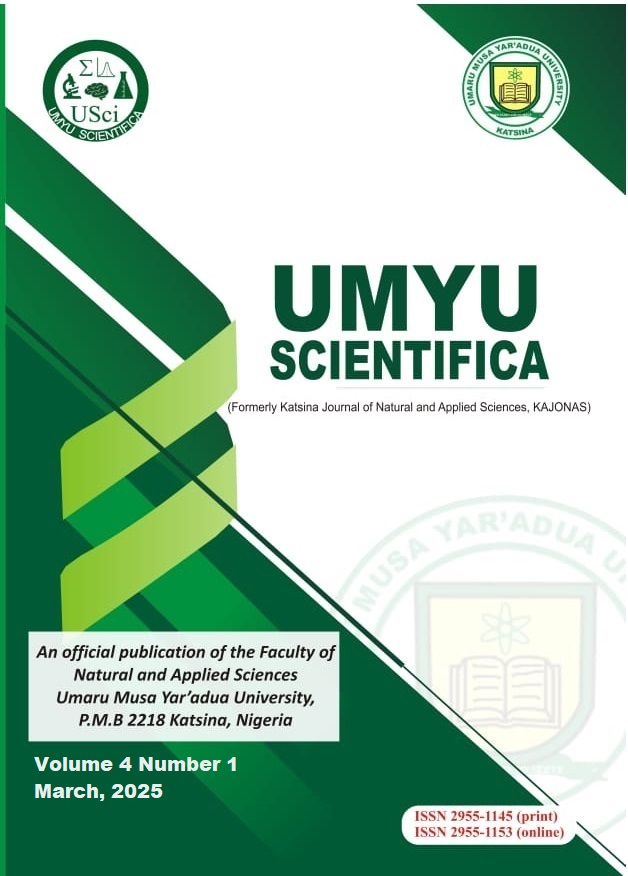Comparative Analysis of the Photovoltaic Properties of Copper (I) Oxide/Copper (I) Sulphide [N-Cu2O/P-Cu2S] Heterojunction Solar Cells Fabricated by Immersion and Heating Techniques
Main Article Content
Abstract
Study’s Excerpt:
• The study investigated the effect of different fabrication methods on the performance of n-Cu₂O/p-Cu₂S solar cells.
• The heating method on this study involved annealing the sample in a copper sulfate solution at 80 degree for one hour.
• The photo response of n-Cu2O/p-Cu2S solar cell formed by the immersion method gives an Isc of 16 µA and Voc of 77 mV which is higher than that of the heating method which gives an Isc of 8 µA and Voc of 40 mV.
Full Abstract:
Cuprous oxide (Cu2O) is a promising semiconductor material for photovoltaic devices due to its low cost, non-toxicity, and high absorption coefficient. This study successfully deposited n-type Cu2O layers using two electroless methods: immersion and heating. The heating method involved annealing the sample in a copper sulfate solution at 800 for one hour. As the second layer, the p-type copper (I) sulphide was formed on an n-Cu2O substrate by sulfidation using 0.05M Na2S to form the desired n-Cu2O/p-Cu2S heterojunction solar cell. The morphological and structural analyses of the materials were carried out using a Scanning Electron Microscope (SEM) and X-ray diffractometer (XRD), respectively. The SEM shows that the n-Cu2O layer is composed of grains of different sizes, which were improved by annealing the sample at 300oC. The results showed that the immersion method produced a solar cell with improved photoresponse, yielding an open-circuit voltage (Voc) of 77 mV and a short-circuit (Isc) of 16 µA, compared to the heating method, which gives a response of: Voc = 40 mV and Isc = 8 µA.
Article Details

This work is licensed under a Creative Commons Attribution-NonCommercial 4.0 International License.
References
Abdu, Y., & Musa, A. O. (2009). Copper (I) oxide (Cu₂O) based solar cells a review. Bayero Journal of Pure and Applied Sciences, 2(2), 8-12.
Abdu, Y., & Musa, A. (2011). Copper (I) oxide (Cu₂O) based solar cells - a review. Bayero Journal of Pure and Applied Sciences, 2(2), 8-12. https://doi.org/10.4314/bajopas.v2i2.63717
Bushra, K. H., Khudayer, I. H., & Ayser, J. I. (2014). Effect ambient oxidation on structural and optical properties of copper oxide thin films. International Journal of Innovative Research in Science, Engineering and Technology, 3. ISSN: 2319-8753.
Ezenwa, I. A. (2012). Optical analysis of chemical bath fabricated CuO thin films. Research Journal of Recent Science, 1(1), 46-50.
Hiroki, K., Takeo, O., Akiyama, T., & Atsushi, S. (2012). Fabrication and characterizations of CuO-based solar cells. Journal of Material Science Research, 3(1). https://doi.org/10.5539/jmsr.v1n1p138
Hafsa, S., Mohammad, R. P., & Padmini, P. (2012). A review: Synthesis, characterization, and cell performance of Cu₂O based solar cells. An International Open Free Access, Peer Reviewed Research Journal, 28(3), 1533-1545. https://doi.org/10.13005/ojc/280361
International Energy Agency. (2022). Solar PV: A key driver of the energy transition. https://www.iea.org
Kara, R., Lahmar, H., Mentar, L., Siab, R., Kadirgan, F., & Azizi, A. (2018). Electrochemical growth and characterization of Cu₂O:Na/ZnO heterojunctions for solar cells applications. Journal of Alloys and Compounds, 817(020006), 2-8. https://doi.org/10.1016/j.jallcom.2019.152748
Kazuya, F., Oku, T., Akiyama, T., & Suzuki, A. (2012). Fabrication and characterization of copper oxide-zinc oxide solar cells prepared by electro deposition. Journal of Physics. https://doi.org/10.1088/1742-6596/433/1/012024
Minami, T., Nishi, Y., & Miyata, T. (2016). Cu₂O based solar cells using oxide semiconductors. Journal of Semiconductors, 37(1), 1-9. https://doi.org/10.1088/1674-4926/37/1/014002
Miyata, T., Watanabe, K., Tokunga, H., & Minami, T. (2019). Photovoltaic properties of Cu₂O-based heterojunction solar cells using n-type oxide semiconductor nano thin films prepared by low damage magnetron sputtering method. Journal of Semiconductors, 40(3), 1-4. https://doi.org/10.1088/1674-4926/40/3/032701
Muhammad, M. (2012). Deposition of copper oxide thin films by chemical techniques [Doctoral dissertation, Nagoya Institute of Technology, Japan].
National Renewable Energy Laboratory. (2022). Photovoltaic cell types. https://www.nrel.gov
Ohajianya, A. C., & Abumere, O. E. (2013). Effect of cuprous oxide (Cu₂O) film thickness on the efficiency of the copper-cuprous oxide (Cu/Cu₂O) solar cell. The International Journal of Engineering and Science, 2(5), 42-47.
Salisu, I. K., Yunusa, A., Mohd, K. M., & Mohd, K. A. (2022). Cuprous oxide (Cu₂O) based solar cell thickness dependence. British Journal of Physics Studies. https://doi.org/10.32996/bjps.2022.1.1.1
Shahadan, M., Mohd, R., Liza, N. H., & Hee, A. (2011). Annealing effects on the properties of copper oxide thin films prepared by chemical deposition. International Journal of Electrochemical Science.
Tuama, A. N., Abass, K. H., & Agam, M. A. (2020). Fabrication and characterization of Cu₂O:Ag/Si solar cell via thermal evaporation technique. International Journal of Nanoelectronics and Materials, 13(3), 601-614.
Winkler, N., Edinger, S., Kaur, J., Wibowo, R. A., Kautek, W., & Dimopoulos, T. (2018). Solution-processed all-oxide solar cell based on electrodeposited Cu₂O and ZnMgO by spray pyrolysis. Journal of Materials Science, 53(17), 12231-12243. https://doi.org/10.1007/s10853-018-2482-2
Zhigang, Z., Atsushi, N., & Jiro, T. (2013). Single cuprous oxide films synthesized by radical oxidation at low temperature for PV application. Optical Society of America, 21(9). https://doi.org/10.1364/OE.21.011448
